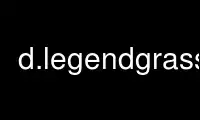
This is the command d.legendgrass that can be run in the OnWorks free hosting provider using one of our multiple free online workstations such as Ubuntu Online, Fedora Online, Windows online emulator or MAC OS online emulator
PROGRAM:
NAME
d.legend - Displays a legend for a 2D or 3D raster map in the active frame of the
graphics monitor.
KEYWORDS
display, cartography, legend
SYNOPSIS
d.legend
d.legend --help
d.legend [-vcnsfd] [raster=name] [raster_3d=name] [lines=integer] [thin=integer]
[labelnum=integer] [at=bottom,top,left,right] [use=float[,float,...]]
[range=min,max] [color=name] [font=string] [fontsize=float] [path=name]
[charset=string] [--help] [--verbose] [--quiet] [--ui]
Flags:
-v
Do not show category labels
-c
Do not show category numbers
-n
Skip categories with no label
-s
Draw smooth gradient
-f
Flip legend
-d
Add histogram to smoothed legend
--help
Print usage summary
--verbose
Verbose module output
--quiet
Quiet module output
--ui
Force launching GUI dialog
Parameters:
raster=name
Name of raster map
raster_3d=name
Name of 3D raster map
lines=integer
Number of text lines (useful for truncating long legends)
Options: 0-1000
Default: 0
thin=integer
Thinning factor (thin=10 gives cats 0,10,20...)
Options: 1-1000
Default: 1
labelnum=integer
Number of text labels for smooth gradient legend
Options: 2-100
Default: 5
at=bottom,top,left,right
Size and placement as percentage of screen coordinates (0,0 is lower left)
bottom,top,left,right
Options: 0-100
use=float[,float,...]
List of discrete category numbers/values for legend
range=min,max
Use a subset of the map range for the legend (min,max)
color=name
Text color
Either a standard color name or R:G:B triplet
Default: black
font=string
Font name
fontsize=float
Font size
Default: Auto-scaled
Options: 1-360
path=name
Path to font file
charset=string
Text encoding (only applicable to TrueType fonts)
DESCRIPTION
d.legend displays a legend for a user-specified raster map or 3D raster map layer in the
active frame on the graphics monitor.
The legend’s default size is based on the dimensions of the active frame, specifically its
height. d.legend will only obscure those portions of the active frame that directly
underlie the legend.
NOTES
When using the at to size & place the legend, a user may create a horizontal legend by
making the box wider than it is tall.
Raster maps based on floating point values will display smoothed, from greatest to
smallest value, while categorical raster maps will display in order, from top to bottom.
Horizontal legends will always be smoothed. If the box is defined with inverted y-values
or an inverted range, the legend will automatically flip. If this is not the desired
result, the -f flag may be used to flip it back.
If the user attempts to display a very long legend in a relatively short display frame,
the legend may appear in unreadably small text, or even revert to a smooth gradient
legend. Use the lines, thin, use, range, and/or -n options to reduce the number of
categories to be displayed, or the -s flag to force a smooth gradient legend.
The lines option will display the first number of categories, as defined by value,
contained in the raster map. When used with the -n flag, it takes on a new meaning: "up to
category #". When used with both thin and the -n flag, its meaning becomes more obscure.
When using lines, auto-scaled text similar to "4 of 16 categories" will be placed at the
bottom of the legend.
The thin option sets the thinning factor. For raster maps with a 0th category, thin=10
gives cats [0,10,20,...]. For raster maps starting at category 1, thin=10 gives cats
[1,11,21,...].
The use option lets the user create a legend made up of arbitrary category values. e.g.
use=1000,100,10,0,-10,-100,-1000
The range option lets the user define the minimum and maximum categories to be used in the
legend. It may also be used to define the limits of a smooth gradient legend created from
a raster containing floating point values. Note the color scale will remain faithful to
the category values as defined with r.colors, and the range may be extended to the limits
defined by the r.colors color map.
The flag -n is useful for categorial maps, as it suppresses the drawing of non-existing
categories (otherwise the full range is shown).
Vertical legends produced with d.legend will place text labels to the right of the legend
box, horizontal legends will place text below. This text will be auto-scaled to fit within
the frame, reducing the size of the legend if necessary. Legends positioned with the at
option will not auto-scale text, in order to provide more control to the user. Smaller
text may be obtained in this case by reducing the height of the box or by using the
fontsize option. The -c and -v flags may be used to suppress the display of category
numbers and labels respectively, or used together to suppress all text of categorial
raster maps.
The text produced from floating-point raster maps will automatically create output with a
meaningful number of significant digits. For very small values, numbers will be expressed
in scientific notation, e.g. "1.7e-9".
When the -d flag is used to display a histogram distribution along side the smoothed
gradient legend, note that the statistics are calculated on the current computational
region settings set by g.region. The default range however covers the entire natural
bounds of the input map. If the histogram appears empty, check your region settings.
If the raster map’s units metadata has been set with the r.support module then it will be
displayed along side the legend.
EXAMPLE
Displaying the legend along with a histogram (North Carolina Sample dataset):
g.region raster=elevation -p
d.rast elevation
d.legend -d elevation
Use d.legendgrass online using onworks.net services
